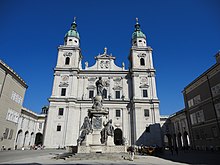Cathedral (building)

Dom (from Latin domus "house") or cathedral church are called churches that are characterized by their size, architectural and artistic peculiarities or a special historical significance.
In Upper German, the term Münster has a similar meaning. Although many cathedrals are also referred to as cathedral , the terms are not synonymous; only churches that serve as Catholic or Orthodox bishopric are called cathedrals .
etymology
The word cathedral for an important church has been used since the 8th century and is an abbreviation of compound Latin names with the component domus "house", e.g. B. domus Dei , "House of God", the place of worship . In contrast, domus ecclesiae was initially the home of the clergy (college, cathedral chapter ) next to the church. In Latin domus is feminine , e.g. B. sancta domus "holy house".
Related words are used in Italian, Scandinavia and a few other languages: Italian duomo , Danish domkirke , Dutch dom or domkerk , Norwegian domkirke , Swedish domkyrka , Finnish tuomiokirkko , Estonian toomkirik , Latvian doms , Slovak dóm .
Only in the 18th century from the French ( DOME ) and English ( dome ) the name Dom for a dome over. Since then, other structures, often including churches, have also been referred to as “cathedral”, but without actually being a cathedral church or a minster. Examples of this are the German and French Domes on Berlin's Gendarmenmarkt and St. Peter's Basilica in Rome.
Country-specific features
Italy
In Italy it was wealthy cities that built their representative duomo even without a bishop .
Germany
Some of the imperial domes , which are particularly associated with the history of the Holy Roman Empire and individual emperors , also had a bishopric, others none.
Today's Protestant cathedrals were - with exceptions in Berlin - built before the Reformation and then lost their function as a bishop's church. In the case of Protestant cathedrals in Germany, the designation cathedral basically refers to their pre-Reformation status as a cathedral.
Under the domes there are:
- Catholic cathedrals (built as a cathedral or later elevated to a cathedral)
- Catholic former cathedrals (the diocese was abolished or the bishopric moved)
- other Catholic collegiate churches or former collegiate churches
- other Catholic churches
- former Catholic cathedrals or collegiate churches, now Protestant churches
- other former Catholic churches
- originally Protestant churches
Among the imperial domes there are:
- Coronation churches with and without a bishopric
- Palace churches with and without other functions
- an imperial foundation with no other function
Austria
In Austria, all Austrian Roman Catholic cathedral churches are known under the name Dom , i.e. the archbishopric churches Vienna (Stephansdom) and Salzburg (Virgildom) , and the seven suffragan churches Eisenstadt , Linz (New Cathedral) and St. Pölten (Archdiocese of Vienna), Feldkirch , Graz-Seckau , Gurk , Innsbruck (Archbishopric Salzburg), as well as a few former cathedral churches (such as the Old Linz Cathedral , the Cathedral of Wiener Neustadt or the cathedral and parish church of St. Andrä / Lavanttal ) - the military cathedral church at the Theresian Military Academy Wiener Neustadt and the immediate Wettingen-Mehrerau are not called the cathedral , nor are the Greek Orthodox and Russian Orthodox Metropolitan Churches and the main churches of other denominations. In addition, the expression is generally used in the sense of “large church”, for the rural deanery parish church of St. Johann im Pongau ( Pongau Cathedral) or Stiftskirche Spital (Dom am Pyhrn), which is extraordinarily large for the region .
In total there are twelve episcopal churches (eleven Catholic, one Greek Orthodox, one Russian Orthodox), and about fifteen churches called Dom in Austria. Cathedrals in the Gothic type is available in Austria among the great churches only sporadically (St. Stephen's Cathedral, Wiener Neustadt, Mariazell ), a few cathedrals Italian style (Renaissance / Baroque: Salzburg, Alter Dom Linz), and a few gotisierte or Baroque style vorgotische basilicas , historicist Numerous imitations (such as the Votive Church in Vienna ). The word "Münster" is not in use.

Scandinavia joined the Reformation in the 16th century. The Protestant episcopal churches are usually referred to as the cathedral ( domkirke, domkyrka, tuomiokirkko ). The few cathedrals of the Catholic Church in Scandinavia are mostly architecturally inconspicuous buildings from the 19th and 20th centuries.



